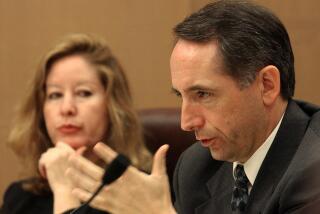The HP virus
- Share via
AS IT TURNS OUT, Hewlett-Packard Chairwoman Patricia C. Dunn didn’t have to order her minions to invent a disgruntled HP executive. She can now become one herself by adding “former” to her title. That’s because the HP board defenestrated her Friday in one of the more satisfying denouements to one of the more embarrassing corporate dramas in recent memory.
The plan to create a fictitious unhappy HP executive, which Dunn approved, was part of an effort to trick a reporter into revealing her sources at the company. The announcement of Dunn’s ouster came after two weeks of revelations about the leak investigation, which started under former Chief Executive Carly Fiorina in early 2005 but intensified this year. According to the company, its security contractors obtained personal phone records under false pretenses; sent a kind of spyware to a reporter via e-mail; conducted surveillance on HP board members, relatives and at least one reporter; and even suggested planting spies at news organizations.
For her part, Dunn insisted that she didn’t do anything wrong, issuing a statement that HP’s click-and-dagger contractors “let me and the company down.” It’s difficult to gin up much sympathy for Dunn, but it’s also hard not to see her as a scapegoat. Evidence abounds that other top HP executives -- including Chief Executive Mark V. Hurd, who now adds “chairman” to his nameplate after Dunn’s removal -- were told about at least some of the deceptions and intrusions planned by its contractors. Hurd admitted Friday that he’d been told about the plan to create a fictitious HP employee to plant stories. A lawyer that Hurd hired to get to the bottom of the mess, Mike Holston, said Friday that HP’s chief ethics officer and the firm’s lawyers told HP’s leadership that the techniques being used were legal.
Setting aside for a moment that some of the methods used were almost certainly illegal, the kinds of deceptions practiced by HP’s contractors don’t pass the smell test. A key part of the plan, which Hurd said he doesn’t recall being told about, was to e-mail the reporter a purported scoop in an attachment that was bugged. Malicious software programs are among the biggest problems faced by the computer industry and its customers, so it’s mystifying why a computer manufacturer such as HP would even think about a stunt like this. Then again, maybe HP executives just weren’t thinking at all.






